Ijraset Journal For Research in Applied Science and Engineering Technology
- Home / Ijraset
- On This Page
- Abstract
- Introduction
- Conclusion
- References
- Copyright
Underwater Communication System
Authors: Ankit Sinha, Anuj Kumar Gupta, Yash Kumar, Dr. M. Neelaveni Ammal
DOI Link: https://doi.org/10.22214/ijraset.2023.51456
Certificate: View Certificate
Abstract
Sensor network have since been considered a promising alternative to complement conventional monitoring processes. These networks are relatively affordable and allow measurements to be taken remotely, in real-time and with minimal human intervention. we are going to use a under -water Wireless sensor network system which can transfer multiple data from one place to another while being attached to an Autonomous underwater Vehicles (AUV) while submerged in water. The concept of transferring data is based on two main components name as Transmitter and Receiver. It can transfer the signal underwater without Internet connection here, the depth of the water in which it can transfer the signal depends on the transmitter module. It has Alarm Sensors system that will get activated if there some disturbance with AUV. It can be used in multiple purposes for both commercial and militarily like Navy.
Introduction
I. INTRODUCTION
Underwater wireless communications play an important role in marine activities such as environmental monitoring, underwater exploration, and scientific data collection. Underwater wireless communications still remain quite challenging, due to the unique and harsh conditions that characterize underwater channels. These conditions include for example severe attenuation, multipath dispersion, and limited resource utilization. Nonetheless advanced communication techniques using acoustic, electromagnetic and/or optical waves have emerged to tackle fundamental and practical challenges of underwater wireless communications. Recently, many academic and industrial researchers have paid attention to the development of state-of-the-art solutions for future underwater wireless communications and networks. This Special Section will enlighten and guide the potential research communities about the recent progress in the area of underwater wireless communications, and will encourage some of the leading research communities o present the state-of-the-art contributions and future research directions
II. LITERATURE SURVEY
- Title: Preliminary Characterization of Coverage for Water-to-Air Visible Light Communication through Wavy Water Surface AUTHORS: Tianrui Lin, Nuo Huang, Chen Gong, Jianghua Luo
YEAR: 2021
In this study, they use a green light emitting diode (LED) to create a water-to-air visible light communication (VLC) link and examine the coverage properties of the planned water-to-air -VLC link in both still and choppy water. We extract the variation in link gain by sending a high-frequency sinusoid signal. We determine the true link gains at various receiver points using the signals received from an experimental water-to-air -VLC system, and we examine the channel temporal characteristics in good connection conditions (referred to as link "on" state). Due to the wavy water surface's random spatial modulation effect, it is observed that the mean channel gain under wavy water surface conditions can be higher than that under calm water surface conditions, especially when the transmitter and receiver are not precisely aligned.
2. Title: Internet of Water Things: A Remote Raw Water Monitoring and Control System AUTHORS: Abílio c. da silva Júnior, Roberto Munoz
YEAR: 2021
Quality control is becoming more important as communication technology develops. The main objective of this endeavour is to create a new online Many governments and international organisations are concerned about the planet's limited water resources. The Internet of Water Things is a term used to describe intelligent water management and monitoring systems. Control and resource management of raw water would be the goal of the proposed system. As a result, a platform based on server-less architecture and the Internet of Things Architectural Reference Model has been built, and it is being used in a simulation environment to test its performance. There is a mechanism for collecting untreated water from tube wells for this research. There are level, temperature, and pressure sensors in each well.
3. Title: Research on The Overall Framework of Intelligent Water Conservancy Construction AUTHORS: Shaoxuan Li, Xiaowan Chen, Xiao Zhang year 2021
China's water conservation has undergone a number of stages, from farming to the rapid expansion of the digital world, and has now formally entered a new phase known as intelligent water conservancy. In terms of safe and reliable operation as well as all-encompassing advantages, intelligent water conservation is one of the primary responsibilities of the water conservation sector. This study presents a set of workable general frameworks for building intelligent water conservancies based on modern electronic information technologies.
4. Title: IoT based Water Parameter Monitoring System AUTHORS: Krishna S, Sarath T V, M S Kumaraswamy, Vishnu Nair YEAR: 2020.
Water monitoring systems are a major topic of discussion in society due to the steadily increasing contamination of water bodies brought on by both man-made activities and natural disasters. Applications involving water have a lot of possibilities for automation. There are many verticals in water quality, smart irrigation, and smart water distribution network thanks to the development of big data analytics. With accurate and current data, all of these function effectively. The most significant obstacle to the creation of an automation application in this field is the need for many sensor parameters and a reliable communication architecture that can be expanded to various areas of water monitoring applications. In this study, a solution to these issues is proposed. EXO Sonde obtains the appropriate sensor values by the usage of an industrial multi-parameter sensor node.
5. Title: Smart Water Meter using Power Line Communication (PLC) Approach for measurements of Accurate Water Consumption and Billing Process
AUTHORS: Abdul, Shaik Asif Hussain, Ajay Rana YEAR: 2020
With the introduction of the internet, data transmission techniques have undergone a significant evolution. There are two sorts of data transmission techniques. One network type is wired, and the other is wireless. One of the methods for transmitting power using specialised modems that collect data at predetermined frequencies is power line communication. The study suggests a smart water metre that measures domestic water use using a flow sensor. The electronic valve in the proposed system will be set to a threshold limit that will turn off the water. The data will be transmitted to the data centre through grid power line and PLC modem for examination. The data centre then sends the water billing department information through SMS for billing purposes.
III. PROBLEM STATEMENTIn existing system people uses Radio Frequency based communication system in underwater for transfer of signals from one place to another but, there are certain disadvantage such as in some area the optical cable might get broken or damage due to disturbance of water. To fix that problem we are using Wireless communication system to tackle that problem.
IV. METHODOLOGY
The data transmission module was submerged in water, and the Data communication transmission module from the controller in the transmitter side sends the data to the reception side through the water.
- Transmission: A transducer is used to transfer the digital signal via the water. This device changes the electrical signal into an acoustic signal that can travel through the water.
- Data Encoding: The information that needs to be conveyed is converted into a digital format and broadcast as a sound wave via the water.
- Receipt: A hydrophone is used by the receiving water communication module to find the acoustic signal in the water. The hydrophone then changes the acoustic signal back into an electrical signal so that a computer or other digital device may process it decoding of data
A. Working Of Proposed System
In this project, they create a mechanism that can wirelessly transport data between two points. Here, the image transmission is accomplished using water as a communication medium. Our system is made up of a few ATMega328 micro controllers, as illustrated in the block diagram (figs. 3.1 & 3.2).
There are transmitter and receiver modules in this system. They use a microcontroller, LCD display, water data communication transmitter module, UART interface, and Visual Basic software in the transmitter end. The user provides the image that has to be transferred, which is then encoded in Visual Basic 6.0 and sent to the microcontroller via the UART interface. Then, a Water data communication transmitter module transmits the encoded image to the receiver module.
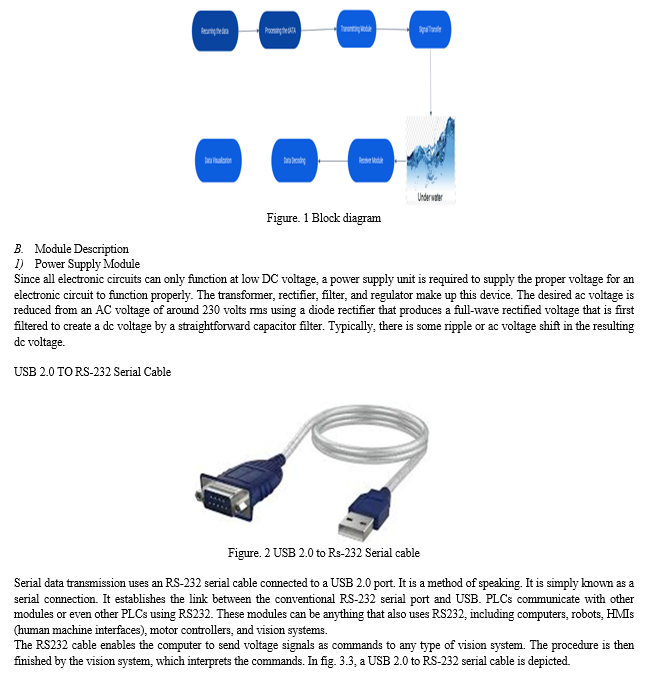
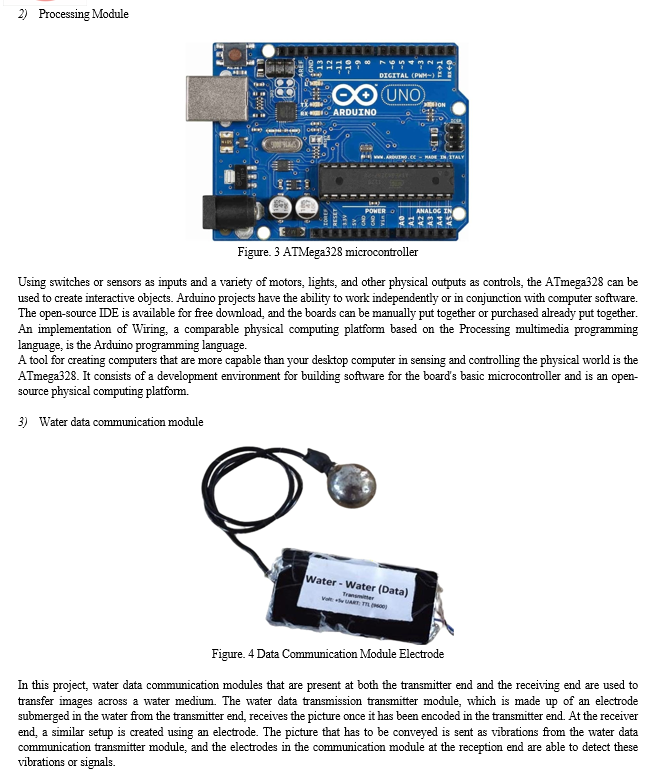
C. Software Description
- Visual Basic: Microsoft suggested Visual Basic be a respectably user-friendly language. The development of graphic user interface (GUI) programmes quickly, the introduction of data bases utilising Data Access Objects, Remote Information Objects, or ActiveX Data Objects, and the creation of ActiveX controls and articles are all capabilities of Visual Basic, which was acquired from Essential. With the use of the components provided by the Visual Basic programme itself, a designer may create an application. The group of computer programmers later created outcast components. Similar to how Visual Basic projects may use the Windows API, which calls for external limit statements. Programmers may easily alter code by dragging and dropping items using the graphical user interface (GUI) provided by Microsoft's Visual Basic event-driven programming language and environment.
- Graphical user Interface: Instead of text-based user interfaces, written command labels, or text navigation, the graphical user interface (GUI) enables people to interact with electronic equipment using graphical icons and auditory indicators like primary notation. The apparent steep learning curve of commandline interfaces, which require users to input instructions on a computer keyboard, led to the introduction of graphical user interfaces (GUIs). In a GUI, the actions are typically carried out by directly manipulating the graphical components. GUI stands for Graphical Interface, which gives the user a visual representation of communication for simple machine interaction. Graphical User Interface, or GUI. It is a standard user interface with graphic elements like buttons and icons.
V. RESULTS AND INTERPRETATION
Our project's results are described in terms of both hardware and software. Here, the experimental findings from this project's work are discussed.
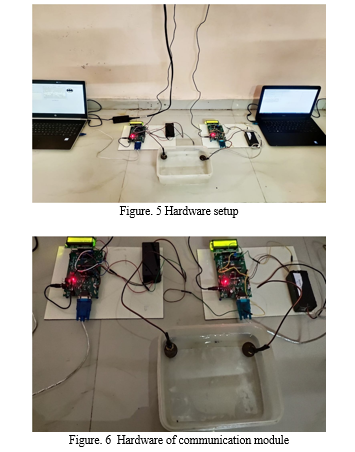
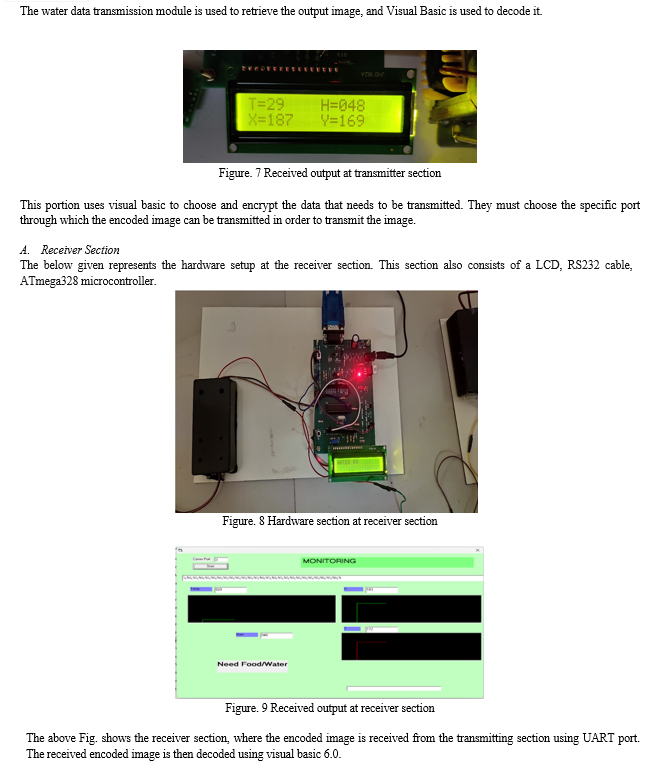
VI. ACKNOWLEDGEMENT
We express our gratitude to Dr. M. Neelaveni for her guidance and support throughout this project, without which it would have been challenging to complete.
Conclusion
The incorporation of sensor networks is expected to help advance numerous application domains and cutting-edge services. This survey provides a concise, in-depth analysis of the current state of the art with an emphasis on cutting-edge sensor network applications. We discussed significant issues that must be addressed, like services and sensor network applications. This unique collection is actually focused on defining the opening salvo in a discussion about the necessary integration of cutting-edge services and applications with sensor networks. We will have a new conversation about the topic of this unique collection when we next meet.
References
[1] J. Catipovic, D. Brady, and S. Etchemendy, “Development of underwater acoustic modems and networks,” Oceanography, vol. 6, pp. 112–119, Mar. 1993. [2] E. M. Sozer, M. Stojanovic, J. G. Proakis, “Underwater acoustic networks,” IEEE Journal of Oceanic Engineering, vol. 25, no. 1, pp. 72-83, 2000. [3] X. Jiang, B. Jun, G. Nan, L. Zhaogeng, “A survey on information-centric networking: Rationales designs and debates,” China Commun., vol. 12, no. 7, pp. 1-12, 2015. [4] D. D. Van and Q. Ai, “An ef?cient in-network caching decision algorithm for Internet of Things,” Int. J. Commun. Syst., vol. 31, no. 8, 2018, Art. no. e3521. [5] J. Wu, M. Dong, K. Ota, J. Li, W. Yang, “Application-Aware Consensus Management for Software-de?ned Intelligent Blockchain in IoT,” IEEE Network, vol. 34, no. 1, pp. 69-75, 2020. [6] H. Liang, J. Wu, S. Mumtaz, J. Li, X. Lin and M. Wen, “MBID: MicroBlockchain based Geographical Dynamic Intrusion Detection for V2X,” IEEE Communications Magazine, vol. 57, no. 10, pp. 77-83, 2019. [7] X. Lin, J. Wu, S. Mumtaz, S. Garg, J. Li, and M. Guizani, “Blockchainbased On-demand Computing Resource Trading in IoV-Assisted Smart City,” IEEE Transactions on Emerging Topics in Computing,, DOI: 10.1109/TETC.2020.2971831, 2020. [8] K. Wang, J. Wu, X. Zheng, A. Jolfaei, J. Li, D. Yu, “Leveraging Energy Function Virtualization with Game Theory for FaultTolerant Smart Grid,” IEEE Transactions on Industrial Informatics, DoI: 10.1109/TII.2020.2971584, 2020. [9] X. Lin, J. Wu, A. K. Bashir, J. Li, W. Yang, and J. Piran, “Blockchain-Based Incentive Energy-Knowledge Trading in IoT: Joint Power Transfer and AI Design,” IEEE Internet of Things Journal, DOI: 10.1109/JIOT.2020.3024246, 2020. [10] T. Qiu, Z. Zhao, T. Zhang, C. Chen and C. L. P. Chen, ”Underwater Internet of Things in smart ocean: System architecture and open issues”, IEEE Trans. Ind. Informat., vol. 16, no. 7, pp. 4297-4307, Jul. 2020.
Copyright
Copyright © 2023 Ankit Sinha, Anuj Kumar Gupta, Yash Kumar, Dr. M. Neelaveni Ammal. This is an open access article distributed under the Creative Commons Attribution License, which permits unrestricted use, distribution, and reproduction in any medium, provided the original work is properly cited.
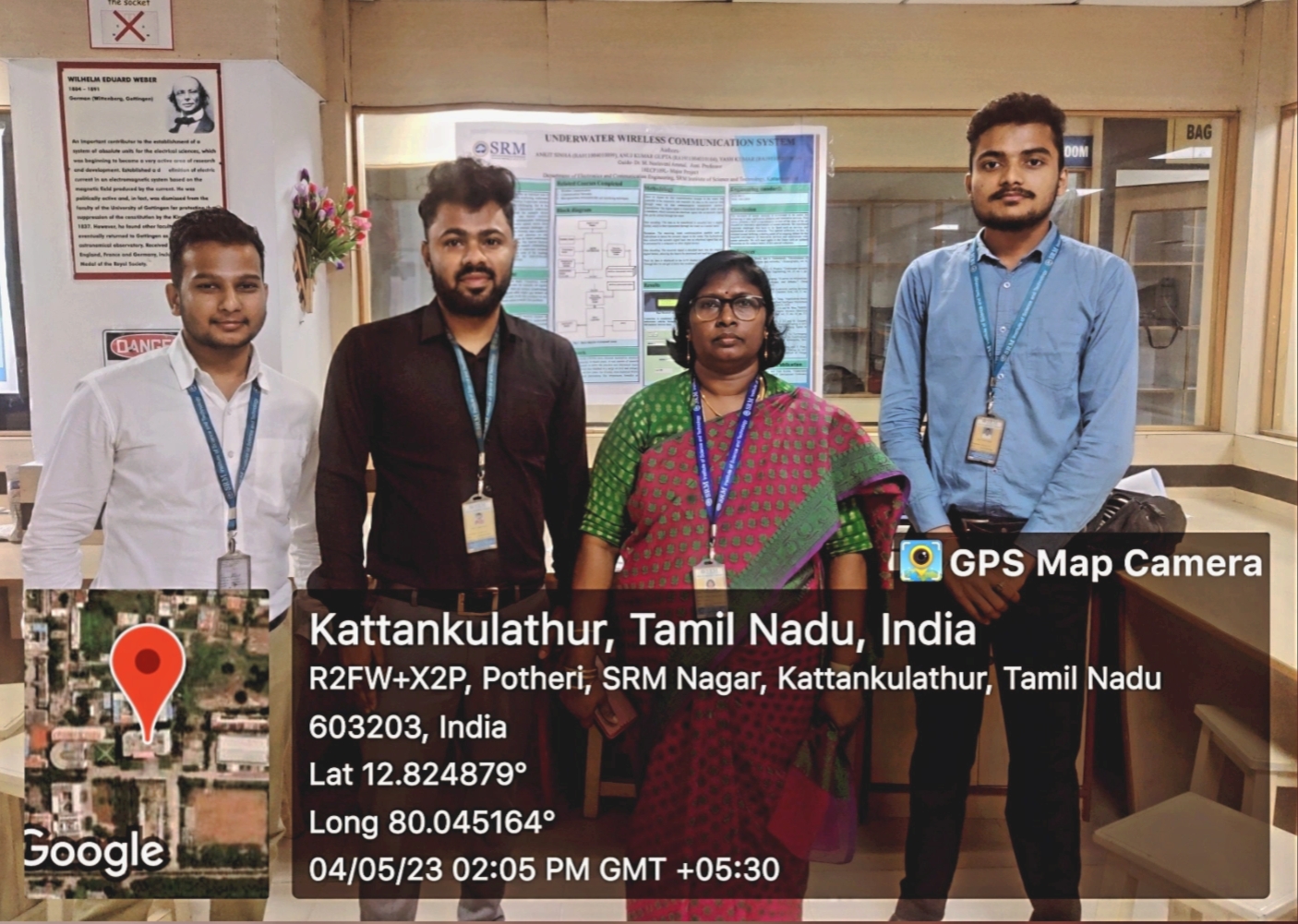
Download Paper
Paper Id : IJRASET51456
Publish Date : 2023-05-02
ISSN : 2321-9653
Publisher Name : IJRASET
DOI Link : Click Here
 Submit Paper Online
Submit Paper Online

